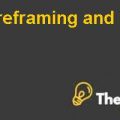
- Describe how traditional reinsurance contracts work. Why are they specifically useful for insurance companies? Give a numerical example (hint: consider how reinsurance affects an insurance company's capital requirements and its ROE).
ANSWER
Reinsurance is a type of contract, in which two insurance companies’ ties together to mitigate the risk. In this contract, one insurance company (also known as cedent company) wants to mitigate its liquidity risk (credit/default risk) by entering into agreement directly with the other insurance company (also known as reinsurer) to insure these risks. These insurers agree to pay claims on shares incurred by the cedent; in return the cedent company pays reinsurance premiums to the reinsurer. It is also possible for cedent companies to enter into the reinsurance agreement through a broker. These brokers work as risk managers on behalf of the cedent company.
For example if Company A sells $10 million worth of policies, and each policy with the $100,000 limit. Company A will lose $100,000 on each policy and to mitigate this risk, it will be better to reinsure this amount of risk and for that Company A will reinsure this amount with another insurer company. Example is also defined in the table below:
|
Cedent company |
|
| Total Policies | 100 |
| Per Policy Cost | $ 100,000 |
| Total Risk | $ 10,000,000 |
To mitigate the liquidity risk, insurance companies reinsure their policies with other reinsurance companies and this generates the cost of interest which saves the tax but this cost also reduces the retained earning which creates the capital requirement. Return on equity also gets affected from this and results in lower return on equity.
- 2. What is the cost of reinsurance currently; calculate the costs of reinsurance for layers 1, 2, 3, 4, and 5? Why is ROL typically higher for lower levels? How much reinsurance do you think USAA can obtain? How much impact will this have on its ROE?
ANSWER:
Currently the cost of reinsurance is defined in different layers and these layers are defined as private or public insurances from which USAA is insured with. The costs of all the 5 layers are calculated using formula given below:
The price of reinsurance calculated through incorporation of actuarial probability will be losses in the layers. The formula used in this calculation is as follows:
The reinsurance price of lower levels are higher because the probability of lower losses are more than the higher level of layers and these higher level of losses occur rarely and higher layers are directly proportionate with the scale of catastrophes. These affects are totally dependent on the probability of catastrophes occurrence. If a catastrophe occurs and is recorded at higher level of scale than the probability of losses would also be higher. The below table shows the probability of losses with the reinsurance cost.
|
Cost of Reinsurance |
LAYER 1 | LAYER 2 | LAYER 3 | LAYER 4 | LAYER 5 |
| Premium Paid | 24 | 17 | 15 | 7 |
- |
| Limit in %age |
90% |
90% |
75% |
60% |
- |
| Upper Limit in Amount | 450 | 600 | 800 | 1,000 | 1,500 |
| Lower Limit in Amount | 125 | 450 | 600 | 800 | 1,000 |
| Reinsurance on Line |
8.3% |
12.5% |
10.0% |
5.5% |
5.5% |
| Price of Reinsurance |
3.17 |
1.8 |
4 |
1.75 |
1.75 |
- 3. Describe how surplus notes work for an insurer like USAA. How contingent surplus notes do work? What is the difference between these two (you need to draw a diagram) and how will each affect an insurer's capital requirements and ROE?
ANSWER
|
SURPLUS NOTE |
CONTINGENT SURPLUS NOTE |
|
| Surplus notes work as the equity instrument for insurance companies through which insurance companies mitigate their liquidity risk. Surplus notes work for the catastrophic situation, where the policy makers establish a trust with the purpose of selling insurer’s own promissory notes to investors and it also proceeds with sales-proceeds in liquid securities. It pays interest rates above the market rate of interest. Surplus notes are also known as promissory notes. Insurance companies can raise funds through issuance of surplus notes to its established trust for the exchange with securities which it concerts into cash. Insurance companies like USAA, can increase their assets through surplus notes but it cannot create liability or increase the liabilities as it is considered to be the policy holder’s surplus. It matures in 10 years or 30 years. | Contingent surplus note is secondary to all the obligations and claims. In this interest and principle payments of contingent surplus notes had to be paid in the same period of time with approval of the state regulators. In contingent surplus notes, independent trust is the buyer of the surplus notes and these surplus notes are issued by insurance companies. |
.......................
This is just a sample partial case solution. Please place the order on the website to order your own originally done case solution.
Describes the first major funding risk using catastrophe bonds. Provides a basis for discussing the securitization of insurance risks. "Hide
by Kenneth A. Froot, All Seasholes Source: Harvard Business School 19 pages. Publication Date: July 10, 1997. Prod. #: 298007-PDF-ENG











